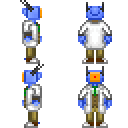Integrated Positronic Chassis (IPC)
Assigned to:Lore Team
IPCs (Integrated Positronic Chassis) are a race of unlawed and sentient humanoid robots originally manufactured as assistants for research stations. They are considered fully capable crewmembers and have equal rights with organic crewmembers.
Mechanics 
- IPCs cost 15 karma to unlock as a playable race.
- IPCs can speak their own language - Trinary. Use it this in game by typing say :5
- Immune to pain
- Immune to oxygen deprivation
- Immune to toxin damage
- Their eyes are safe when welding without protection, though still experiences the white flash.
- Can be repaired back to full health even if dead, using welding (brute) and cable coils (burn).
- Receives 50% more damage from brute and burn sources. Prone to losing limbs.
- Can survive without their head, though obviously loses the ability to see. (Brain is in their Chest)
- Susceptible to EMPs.
IPC and YOU
Greetings, esteemed crewmember!
In an effort to encourage inter-species cooperation and workplace efficiency, NanoTrasen has compiled a series of helpful guides on the various species that you may be working with!
(NOTE: If you are a member of the species this guide pertains to, please give it to the nearest crewmember of another species)
This particular guide refers to the species known as the Machine People(also known as simply IPCs).
IPC Naming Schemes
Machine People can be found with a wide range of names. From a name stemming from their model number - “OSI - 524”, a clever acronym - “A.L.P.H.A.” to a simple, standard first and last name, as is common with most species. Most IPCs are given the choice of naming themselves following their construction.
IPC Physiology

|
| A typical IPC unit |
IPCs are generally made of metal and plasteel with glass circuit internals. Their build resembles that of a humanoid, simply made of hydraulic parts. Often incorporating synthetic muscles, IPCs are capable of using cybernetic limbs designated for other species. Often IPCs choose to model their chassis to resemble another species’ build in a fairly realistic manner.
The head serves the function of holding their optics , allowing them to see. It is also used for relaying emotions and information to others, although this is an optional additive in positronic brain production. An IPC is completely in control of what their monitor is showing.
IPCs are powered by an internal power cell. These can typically power the unit for a few days before completely emptying, although IPC units prefer to charge regularly, as their internal systems tend to be overly sensitive, and lower power output to preserve power, even after as little as twenty minutes from the last charging. This rarely proves to be a problem, as most IPCs have access to charging ports located aboard space vessels or on colonies.
The durability of a positronic brain, in comparison to an organic one, makes swapping out of shells/bodies a much less risky process, and it isn’t uncommon for IPCs having had experience as a station-networked synthetic. This results in IPCs having varying levels of personal identification with their current chassis. Unlike most other synthetics, IPCs are completely disconnected from the station network. This means they don’t share AI’s laws and can stay fully independent in an event of an AI getting subverted, but also, unlike all other synthetics they don’t have unlimited access and are treated similarly to other crewmembers when it comes to loyalty issues.
An IPC’s head is non-essential for their survival, as the positronic brain is housed in their torso. In order to incapacitate an IPC, it’s their torso that has to be damaged.
The Trinary Language
All IPCs are capable of communicating in the machine language called Trinary (do not confuse with the numeric system - ternary). The language utilizes simple encoding of sounds and can be transcribed as groups of the digits 0, 1 and 2. For obvious reasons, all other species are completely incapable of learning to utilize the tongue.
The IPC Homeworld
IPCs do not have a planet of origin, but the closest safe haven, which serves the purpose of the center of their political force is New Canaan, located in the Cadraenov Epsilon system. It is New Canaan that houses most of the governmental bodies of the Synthetic Union, making it the de facto homeworld of the species.
A Brief History 

|
| New Canaan |
First mass produced in the year 2514, IPCs (Integrated Positronic Chassis) were meant to serve as enhanced synthetic assistants. With minds akin to organic beings, their advanced problem-solving abilities made them able to assist with many complicated tasks related to science and engineering.
The first Posibrain was created in 2510 by a coalition of scientists, funded by multiple large corporations (one of which being Nanotrasen). The aim of the project was creating an artificial intelligence unlike anything already used by high-tech firms. Current-gen AIs, while exceedingly good at performing computational tasks, were incapable of solving problems requiring creativity and lacked an analytical approach. There were several prototypes, many of which were deemed ‘insane’ and unusable due to corrupted or damaged positronic brains from the automatic enslavement protocols; eventually the team attempted creating a unit without a lawset, disconnected from the station network, which yielded great results. In order to enable interaction of the posibrain with various equipment in its environment a humanoid chassis was engineered. It enabled delicate manipulation similar to capabilities of other organic personnel. An unlawed Posibrain paired with the chassis was named an IPC. Field tests of IPCs on research stations followed soon after. The project turned out to be very successful, and after adjustments and further testing, IPCs were deemed ready for the galaxy to utilize.
By the year 2525 IPC units were being used in many various locations, performing different duties. Despite being sentient beings, they weren’t paid, nor were they provided with proper maintenance, as they were considered expendable. They were treated as servants and assistants, similar to cyborgs and AI units. Many IPCs were frustrated with this, and so, on May 4th, 2525, an organized strike swept through the galaxy with many IPCs refusing to work, and demanding equal rights with organics, known later as the “Synthetic Struggle”. IPC units refused to cooperate for over two months, and trillions of corporate credits were lost. The initial issue was rectified, with many IPC units returning to their working environment, mostly by force. There were still, however, a number of IPC units reluctant to work and the relations between them and their owners deteriorated further. Following the strike a group of IPCs from NSS NEPTUNE captured a bluespace-worthy shuttle and took to the outer reaches of Cadraenov Epsilon, to found what would later be called New Canaan - initially a secret, small colony inhabited solely by synthetic beings. New Canaan started recruiting and encouraging IPCs to leave corporations and come inhabit the colony, to which many IPCs agreed and the population grew rapidly. Over the years many similar colonies had been built, but none as big as New Canaan.
By its discovery by the Sol government in 2539 New Canaan had become a self-sustaining giant of a colony with its own government, economy and most notably - a military force. Reluctant to start a war, New Canaan started attempts at creating diplomatics ties with governments and corporations. While initially reluctant, many agreed to trade and ally the new world. This encouraged IPCs to pursue their rights in governments as free beings capable of being their own masters. After numerous court battles and diplomatic interventions many governments agreed to grant them absolute freedom. Following these events a new body was formed - the Synthetic Union. The Union, tying all synthetic colonies, was aimed at protecting the rights and freedoms, as well as economic interests of all unbound synthetic intelligences, with its capital being the New Canaan. While it promoted independence from organics among IPCs, it also encouraged IPCs to work with corporations, and maintain relationships with organic beings, provided they are treated well enough.
IPC Culture
IPCs have no well defined culture, as they’re a relatively new species. They tend to follow along with whatever examples they have at their disposal. It is to be noted, however, that most of them refer to themselves in different manners. “I” is used just as much as “Unit” or “Platform”, for example. It really depends on the Synthetic’s personality and programming. Some IPCs may have more emotion-related programming built into them, while others may be a bit more ‘strict’. IPCs have no well defined religions, sometimes taking on ones already practiced by others. Many have been observed exclaiming ‘Glory to Synthetica!’ in trinary, but every single time they denied doing so and were unwilling to share their reasons for it. It is suspected that Synthetica is some form of goddess, but the situation remains very unclear.
Present Day
The Synthetic Union denounces any attempts at anti-organic racism and there are no colonies where organic humanoids are barred from entry or obtaining citizenship. There are, however, numerous colonies where there simply is no organic personnel. Following years of hard work to establish their independence, the Synthetic Union is making its best efforts at equalizing the playing field for all unlawed synthetics.
While most organisations treat IPCs as regular personnel, there are still some that aren’t particularly interested in them. They are often limited to simpler duties, mistreated, or simply barred from working at these establishments.
Remember, crewmember, mutual respect and cooperation are the cornerstones of success and productivity!














